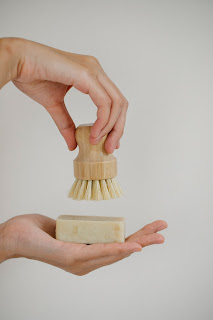Eco-friendly products in the home for a more sustainable future
From cleaning products to mens grooming, to menstrual care, the market is now brimming with eco-friendly alternatives that prioritize the health of our planet. Let's delve into some great ecological products that promote the mantra of "reuse, recycle, and reduce," paving the way for a more sustainable future.
Traditional cleaning products often contain harmful chemicals that not only jeopardize the environment but also pose health risks to those who use them. However, the emergence of eco-friendly cleaning products has revolutionized the way we maintain our homes.
In the realm of laundry, our choices matter more than we realize. Switching to eco-friendly laundry detergents not only helps preserve the environment but also ensures the longevity of our clothes and the well-being of our skin.
A notable innovation in this space is the washing machine eco-friendly detergent sheets. These sheets, often made from biodegradable materials, eliminate the need for plastic bottles commonly associated with liquid detergents. Their compact and lightweight design also reduces transportation emissions, contributing to a more sustainable supply chain.
For decades, the menstrual product industry has been dominated by single-use items that contribute significantly to pollution. However, the rise of eco-friendly menstrual products offers a breath of fresh air for both consumers and the planet. In recent years, there has been a growing shift towards sustainable and eco-friendly alternatives in various aspects of our lives. Menstrual cups and recyclable sanitary towels have emerged as revolutionary options that not only cater to women's health but also contribute significantly to reducing environmental impact. Made from medical-grade silicone or natural rubber, these cups can be reused for several years, drastically cutting down on the waste generated by traditional disposable products.
Embracing a sustainable lifestyle requires a commitment to the three Rs: reuse, recycle, and reduce. Reusable alternatives, such as cloth napkins and towels, not only save money in the long run but also significantly reduce the amount of single-use waste generated daily.
Recycling has become more accessible, with many recycling programs. By sorting our waste diligently and supporting products with recyclable packaging, we actively contribute to the circular economy.
Reducing our carbon footprint involves making conscious choices in our purchasing decisions. Opting for products with minimal packaging, choosing energy-efficient appliances, and supporting companies with transparent sustainability practices are effective ways to reduce our environmental impact.
In the quest for a more sustainable lifestyle, every choice we make counts – even in the grooming department. Traditional shaving routines often involve disposable razors and aerosol-packed shaving creams, contributing to the ever-growing issue of plastic waste. However, the rise of eco-friendly shaving alternatives for men and women provides a silver lining, offering a guilt-free grooming experience that aligns with a greener ethos.
One of the most prominent eco-friendly alternatives to disposable razors is the classic safety razor. Unlike their plastic counterparts, safety razors have a timeless design, featuring a durable metal handle and replaceable, recyclable blades. Though the initial investment may be slightly higher, the long-term benefits outweigh the cost as these razors can last a lifetime with proper care.
Traditional shaving creams typically come in aerosol cans or plastic tubes, contributing to unnecessary waste. Enter shaving soap bars – a compact and eco-friendly alternative. These bars often come packaged in minimalistic, recyclable paper or cardboard, eliminating the need for excess plastic. When lathered with a shaving brush, these soap bars provide a rich and luxurious shaving experience, all while being kind to the environment.
By making informed choices and supporting brands that prioritize sustainability, men and women can redefine their daily rituals, turning a seemingly mundane activity into a positive contribution to the planet. The path to a greener grooming routine is not only achievable but also rewarding, offering a chance to look good while doing good for the environment.
By embracing these innovative products and incorporating the principles of reuse, recycle, and reduce into our daily lives, we are not only creating a healthier environment but also paving the way for a sustainable future. Let's continue this journey together, making choices that prioritize the well-being of our planet for generations to come.#Affiliate links #ads

















